|
So you think you know everything there is to know about snowflakes? Well, heat up some cocoa, nestle down in your favorite easy chair and get ready to learn more -- maybe even everything you always wanted to know about the flakes from above but were too busy catching them on your tongue to ask. By the end of The Story of Snow by Mark Cassino, you'll be wishing for a blizzard so you can follow the instructions he provides for catching and viewing snow crystals.
Ever wonder just how snow crystals form? And what shapes they can take? Is it really true that no two snow crystals are alike? Cassino answers these questions and more in this visually stunning exploration of the science of snow. It's the perfect short read for winter days, with fabulous photos of real snow crystals in all their wondrous diversity.
0 Comments
If you live in Wheaton, Illinois, you will recognize the above as the central slogan for the city's annual holiday celebrations. And with good reason. Charles Dickens wrote no less than five novels centered around the Christmas season! He started off in 1843 with the first and most enduring of his Christmas tales, A Christmas Carol, which is now known as the annual Christmas chestnut or cash cow, particularly among theatre groups and their patrons. But did you know that this beloved story, which sends a message that cuts through the materialistic trappings of the season and gets to the heart and soul of the holidays, was actually written as the result of the author's desperate need of money. In the fall of 1843 Dickens and his wife were expecting their fifth child. Requests for money from his extended family, a large mortgage on his Devonshire Terrace home, and lagging sales from the monthly installments of his latest novel, Martin Chuzzlewit, had left Dickens seriously short of cash. 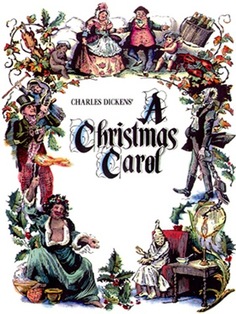 The idea for the story came during a trip Dickens took to Manchester, England to give a speech in support the Athenaeum, a school which provided adult education for factory workers. This experience of championing education as a remedy for crime and poverty, along with a recent visit to the Field Lane Ragged School, a night school for those in abject poverty, made Dickens resolve to "strike a sledge hammer blow" for the poor. At odds with his publishers, Dickens paid for the production cost of the book himself (yes, he self-published!) and insisted on a lavish design that included a gold-stamped cover and four hand-colored etchings. He also set the price at 5 shillings so that the book would be affordable to nearly everyone. The book was published the week before Christmas and became an instant hit. And the rest is history... and annual revivals at the Goodman Theatre. 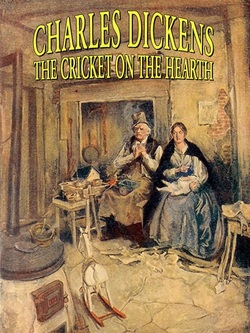 Dickens published four other Christmas books, none of which achieved the same popularity as A Christmas Carol, but each has its own singular charms. The Chimes, published in 1844, tells the tale of Trotty Veck, a poor ticket porter, whose viewpoint is changed from despair to hope by the spirits of the chimes on New Year's Eve. The Chimes is a bit more topical than A Christmas Carol, referencing social problems more specific to the 1840s. As such, it has lost some of its relevance to today's audience. The Cricket on the Hearth, published in 1845, centers on John and Dot Peerybingle, whose marriage is compromised by its May-December nature. Confronted with Dot's possible infidelity, John consults the spirit of the Cricket on the Hearth, whose chirping supposedly brings good luck. The cricket reassures John that all will be well. The misunderstanding is resolved and the couple's happiness restored. 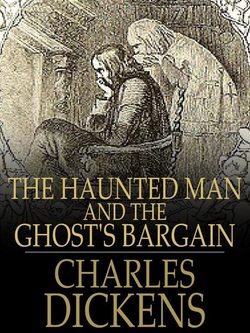 In 1846, Dickens brought forth The Battle of Life, which was the least successful of his Christmas stories. In 1848, he wrote his final Christmas tale, The Haunted Man and the Ghost's Bargain, the story of Mr. Redlaw, a chemistry professor who is tormented by painful memories. He is visited on Christmas Eve by a phantom, his doppelganger, who bestows the gift of forgetting these memories. The catch is that others who come into contact with the professor also lose remembrance of past hurts and sorrows. Redlaw passes on this gift to members of the Swidger family. For some this might seem a good thing, but for others, whose present happiness is based on remembrance of the past, it is a bitter pill. In the end, the gift is reversed by benevolent nature of Milly Swidger, whose raw memories of her lost child are the source of her kindness. For Dickens, Christmas was far more ghostly than any Halloween... Now that we have given Thanksgiving its due place in the holiday pantheon, we can begin to celebrate the season of lights... as well as snow, frostbite, ice and their remedies, hot chocolate. Winter, in those areas of the world that actually experience all four seasons, can be gorgeous and brutal, exhilirating and debilitating, all within the space of a few minutes. But it has also sparked some of the finest fiction bound between two covers. So grab a cup of cocoa, wrap a throw around your shoulders and keep warm with these chilly scenes of winter: 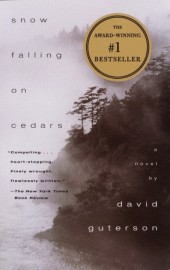 Snow Falling on Cedars by David Guterson is a novel that has been praised for its eloquent dramatization of themes of love, racism, justice and community. It wraps a suspenseful story of a murder trial with a beautiful evocation of lost love, and brooding, poetic descriptions of place and character. It is a blend of courtroom drama and romance that takes place in a small town in Washington. Set in 1954, the novel examines the dynamics of the fictitious community of San Piedro Island after World War II and the aftermath of the Japanese-American internment in that era. 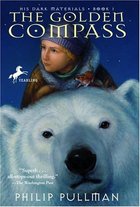 The Golden Compass (originally published in England as Northern Lights) by Philip Pullman is usually designated a young-adult book, but don't let that fool you. It's not just for tweens and teens. It's the first novel in Pullman's His Dark Materials trilogy and it's a wonderous fantasy set in a world that parallels our own, but with magical twists and thoughtful, thought-provoking turns. The novel tells the story of a young girl named Lyra Belacqua who, it turns out, is destined to save the world. Lyra, like the heroes of many children's novels, grows up more or less an orphan, yet lives happily among the scholars of Jordan College in Oxford until her best friend Roger is kidnapped. His disappearance, along with other strange occurrences, sets off a course of events that leads her (with a band of gypsies) into the coldest and darkest part of the earth, the North. You will feel the hostile wind biting your cheeks as you read this book, which manages to be a page-turning thriller AND a philosophical meditation at once. 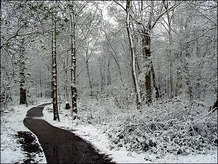 And that's just a start for your winter's reading... next up, holiday stories! I recently had a discussion about how authors go about deciding on names for characters in their novels and plays. This, of course, led to a quick perusal of the Internet, a lively debate and a top-ten list. Or several top-ten lists. This is what happens when librarians have too much time on their hands (which admittedly isn’t very often). 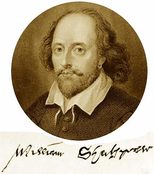 We must, of course, start with the Bard of Avon, who, for the record, I believe actually did write his own plays! Shakespeare is at his wittiest when coming up with clever, charming and apropos names for his characters. Shakespeare’s Top Ten Character Names: 1. Sir Andrew Aguecheek (Twelfth Night) Post nasal drip, anyone? 2. Sir Toby Belch (Twelfth Night) ‘nuff said. 3. Dogberry (Much Ado About Nothing) All constables should be as much of a hoot! 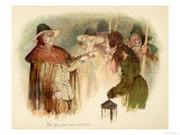 Dogberry on watch 4. Iago (Othello) Just saying the name leaves an evil taste in the mouth! 5. Launcelot Gobbo (and his dad Old Gobbo) (The Merchant of Venice) Shylock’s fun-loving, crude servant 6. Mistress Overdone (Measure for Measure) Shameless hussy 7. Mistress Quickly (Merry Wives of Windsor) Overdone’s equally shameless colleague 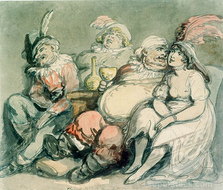 Falstaff and his Doll 8. Doll Tearsheet (Henry IV, Part 2/Henry V) Falstaff’s favorite hussy and BFF with MQ 9. Dr. Pinch (The Comedy of Errors) 10. Puck (A Midsummer Night’s Dream) Devious trickster fairy Honorable mention to Christopher Sly (The Taming of the Shrew) (Oops, guess this one goes to 11!) 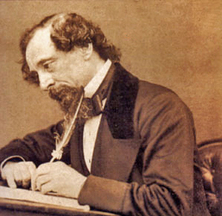 Two-pence Chuck But what about Charles Dickens? His fans will stage a thrown-down for the championship between Chuck and Will at the turn of a page. Dickens' Top Ten Character Names: 1. Uriah Heep (David Cooperfield) Could there be a better name for a villain? (Darth Vader excepted, of course) I mean, you can't think the name without conjuring up images of body waste. 2. Pumblechook (Great Expectations) Pip’s guardian -- his name sounds as loud-breathing and rotund as he is. 3. Mr. Sowerberry (Oliver Twist) Say the name and you will have the very image of the cruel, ugly undertaker on your tongue -- yuck! 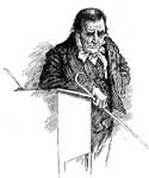 Wackford Squeers 4. Paul Sweedlepipe (Martin Chuzzelwit) Can you say “eccentric?” 5. Wackford Squeers (Nicholas Nickleby) also daughter Fanny, son Wackford, Jr. and Mrs. Squeers. The nasty caretaking family who run the orphanage. Possibly the origin of the phrase “wack-job?” 6. Polly Toodle (Dombey and Son) Plump, jolly nurse -- what else could she be with a name like that? 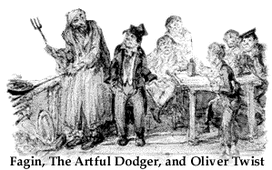 7. Bumble (Oliver Twist) True to his name 8. Fagin (Oliver Twist) Another perfectly named villain 9. Harold Skimpole (Bleak House) Notorious tightwad -- and his name evokes that character defect 10. Seth Pecksniff (Martin Chuzzlewit) One of the biggest hypocrites ever imagined with a wonderfully evocative name. 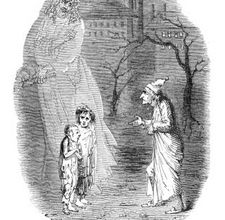 Ebenezer with the twins Ignorance and Want But we can't possibly exclude the one we all know and love: Ebenezer Scrooge (A Christmas Carol). It's a name that has entered the vernacular; everyone knows how miserly a “scrooge” is... Oops, guess this one goes to 11, too! Okay, so I admit to feeling a little retro with my entry of the other day. After all, does anyone “surf” the Internet anymore? The little tech devil/angel that perches on my shoulder was chiding me, “That entry was so 2002. Get with it, babe, it’s almost 2012. Today it’s all apps, apps, apps!!” Hey, I referenced Angry Birds, didn’t I? 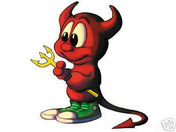 Little tech devil Tech Devil says that doesn’t count. So, in an effort to redeem myself and be the hip, futuristic library media specialist that I sometimes am, I herewith present a selection of apps that we may see somewhere down the road, later or sooner. The catch? These apps were envisioned by students in Kindergarten through 12th Grade in response to a question asked by Speak Up -- Project Tomorrow’s annual survey of educators, parents and kids. Project Tomorrow is a national education nonprofit group based in Irvine, California which supports the innovative uses of science, math and technology resources in schools and communities. The question they asked? “If you could create the ideal mobile app for learning, what would it look like?” Here are some of the most intriguing responses: 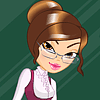 My Teacher Match: “This program scrutinizes how each student learns best through a test that measures their interests, hobbies and special skills. Teachers are quizzed separately on the same criteria and matched up with compatible students.” Submitted by a high school student. An interesting idea, but what happens to those students and teachers who don’t match up well with anyone? Do they get thrown in together in the “Reject” class, like the kids who are always picked last for team sports and dodgeball?  Perhaps in the future, there will actually be jobs to dream about. When I Grow Up: “I would create an online career app with career paths, each with easy-to-read information. For example, a student could select a column called Animals, and choose a career path, like equine vet. Students could browse images and vocabulary terms and even take a short quiz.” Submitted by a middle schooler I like this idea, although there are websites out there that have plenty of good information already available on this topic for students, such as this one from the Bureau of Labor Statistics. 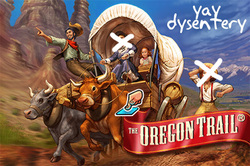 Still a favorite after all these years... Race Against Time: “My game would have kids going through a virtual world using a time machine. The students would learn about history through simulations. Students would create an avatar, which advances with them as they move through each level.” Submitted by an elementary student. Love this idea! I have often wished for more interactive learning games with historical simulations. The Oregon Trail game is still as popular as ever with students and they really do learn through playing it! Including the joys of dysentery, as noted above. 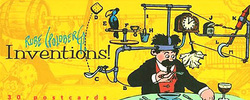 Puzzle Crazy: “My app shows students how to complete a Rube Goldberg puzzle. Students would have to use their imagination to complete a puzzle by using trash to make something.” Submitted by an elementary student. Perhaps this student does not have a well-informed library media specialist at his school. If he did, he would already be familiar with this website, and this one too, which let kids do NOW what he envisions in his future app. 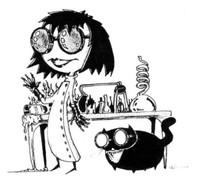 The Lab: “In my game you can choose different chemicals or substances to mix together. When you click the ‘See the Reaction’ button, you’ll find out what happens.” Submitted by an elementary student. Well, this would probably be a lot safer than letting fifth graders run amok with chemicals during their “Mixtures and Solutions” Unit! Bill O'Reilly, TV commentator, attempts to be a scholar in his new book, Killing Lincoln, but the text is so riddled with errors and inaccuracies that one of the bookstores at Ford's Theatre is refusing to carry it. Some of the most egregious errors include numerous references to Lincoln working in the Oval Office, which didn't even exist at the time he was president. (It was built decades later.) O'Reilly also gets his dates wrong several times, including the burning of the original Ford's Theatre, and repeats a theory dismissed long ago by true Lincoln historians that Secretary of War Edward Stanton was involved in the assassination plot. We won't mention the poor overall writing quality (O'Reilly has Lincoln "furl" his brow -- we presume he means "furrow." Unless he had a sail on a mast perched up there. Also, O'Reilly must have figured he is above the standard that all writers of research papers from 5th grade on up are expected to meet: he offers no direct citations for any of his assertions.
Read more here and here. The Internet allows us to communicate instantly across the globe, retrieve information at the click of a mouse, and, of course, waste precious minutes (hours?) of our lives. Here's your guide to the best online diversions to pass that lunch break or late Friday afternoon (or enable you to put off writing that paper for English class). Unless, of course, you are too busy playing Angry Birds on your iPad.
www.bored.com If you don't know where to start your surfing, bookmark this page and try not to get hooked. It links to dozens of miscellaneous sites for games, trivia, weird news and video clips. You can find movie reviews, online polls and the "Calorie Calculator," in case you want to know how many are in that Chipotle Burrito you are scarfing. www.coolsig.com You know those pithy quotes and clever quips people use with their email signatures? Well, someone with a lot of time on his or her hands has collected them by the hundreds and sorted them by topic. Highlights include: "Veni, Vidi, Velcro: I came, I saw, I stuck around" and "Hermits have no peer pressure." There's nothing like a cyber proverb to spice up your most mundane email, as long as your recipient has a sense of humor. www.wordsmith.org/anagram Anagrams, the rearrangement of a word or words to form another, can help you see a word (and the world) from a whole new perspective. This site features an anagram generator that spews out all possible permutations of whatever word you enter, so you can discover that "Herman Cain" can be arranged to spell "March Inane" and "Charm Inane" and "Sarah Palin" "has lain rap." I myself am "innate zen joy." www.snopes.com You read the urban legend on an email chain letter, but how do you know if it's true? The "Urban Legends Reference Page" is one of the most authoritative web sites for debunking myths. The searchable site sorts stories into categories and color-codes them: green for true, red for false and yellow for unknown, and includes references. For the record, it's true that static electricity can cause gas pump fires, false that the nursery rhyme "Ring Around the Rosie" is a coded reference to the Black Plague, and false that Hostess Twinkies have an indefinite shelf life. So ready, set, start wasting some time! I had a young student ask if I knew of any sentences that used every letter of the alphabet. And because I am a librarian, I was able to say, "Why yes, I do!" Then, of course, I proceeded to guide her to enlightenment on holalphabetic sentences, also known as pangrams. The most common example, known to graphic designers and typographers:
The quick brown fox jumps over the lazy dog. However, there are some other, interesting possibilities: Waltz, bad nymph, for quick jigs vex. How piqued gymnasts can level six jumping razorback frogs. We promptly judged antique ivory buckles for the next prize. Sixty zippers were quickly picked from the woven jute bag. Jump by vow of quick, lazy strength in Oxford. Jackdaws love my big sphinx of quartz. Please note: I didn't say they had to make sense. Fairy tale world: the Seven Dwarves: Bashful, Doc, Dopey, Grumpy, Happy, Sleepy and Sneezy
Our world: GOP candidates: Huntsman, Paul, Perry, Gingrich, Romney, Bachman and Cain First graders love to read the dedication pages of books. They exhibit a wonderful curiosity about the who and the why and the how. And working with curious children is a fabulous way to keep one's own curiosity sparked... so the conversation I had the other day with a first grader about dedication pages and their purposes led me to dig into the background of dedication pages in some famous books we all know and (maybe) love... One of my favorite (dare I say my absolute favorite?!?!) novels is The Great Gatsby, which F. Scott Fitzgerald dedicated "Once again to Zelda." This was, of course, his wife, Zelda Sayre. Beautiful, but mentally unstable, she inspired him to literary heights and tormented, personal depths of despair. To say their love and 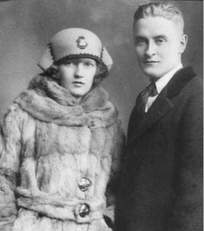 Zelda and Scott their life together were tumultuous would be an understatement. It ended with him mired in alcoholism and her locked in the Highland Mental Hospital. Aaaaah, the writing life.... Then there is Ayn Rand. Recently, I noted that I have not read her doorstops--er, novels, but I did 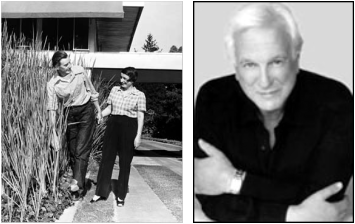 Frank and Ayn, then...Nathaniel now pick up Atlas Shrugged the other day at the library and gave its 1,000+ pages a glance. It's dedication reads: "To Frank O'Connor and Nathaniel Branden." Turns out these two gents were her husband and her lover. Well, alrighty then... moving along... From the sublime to the ridiculous... Jacqueline Susann dedicated her pot-boiler Valley of the Dolls to her poodle, Josephine, who had played a role in a previous book: "To Josephine, who sat at my feet, positive I was writing a sequel... but most of all to Irving." Irving, by the way, was her husband. So we know who came first in her life. I have already informed my cats that my next book will NOT be dedicated to them. |
AuthorTo find out more about me, click on the Not Your Average Jo tab. Archives
February 2024
Categories
All
|
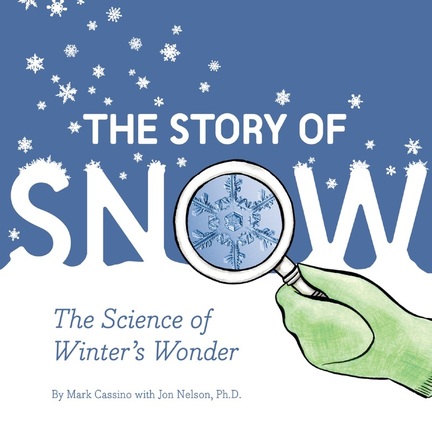

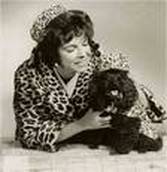
 RSS Feed
RSS Feed